
Kidbrooke is an area of South East London, England, in the Royal Borough of Greenwich 7+1⁄2 miles (12 km) south-east of Charing Cross and north west of Eltham.

Royal Air Force Halton, or more simply RAF Halton, is one of the largest Royal Air Force stations in the United Kingdom. It is located near the village of Halton near Wendover, Buckinghamshire. The site has been in use since the First World War but is due to close by December 2027.

Royal Air Force Brize Norton or RAF Brize Norton in Oxfordshire, about 75 mi (121 km) west north-west of London, is the largest station of the Royal Air Force. It is close to the village of Brize Norton, and the towns of Carterton and Witney.

Royal Air Force Digby otherwise known as RAF Digby is a Royal Air Force station located near Scopwick and 11.6 mi (18.7 km) south east of Lincoln, in Lincolnshire, England. The station is home to the tri-service Joint Service Signals Organisation, part of the Joint Forces Intelligence Group of Joint Forces Command. Other units include the RAF Aerial Erector School, No. 54 Signals Unit and No. 591 Signals Unit.

RAF Henlow is a Royal Air Force station in Bedfordshire, England, equidistant from Bedford, Luton and Stevenage. It houses the RAF Centre of Aviation Medicine, the Joint Arms Control Implementation Group (JACIG), elements of Defence Equipment and Support, and the Signals Museum. It formerly hosted light aircraft flying and 616 Volunteer Gliding Squadron. The Ministry of Defence announced on 6 September 2016 that the base is set to be closed following a consultation. Flying activity ceased in July 2020.

HMP Low Moss is located on the outskirts of Bishopbriggs, East Dunbartonshire; near Glasgow, Scotland. It has been operated by the Scottish Prison Service as a prison since 1968 and was for low-category prisoners who had sentences of less than 36 months to serve. The original establishment was closed in May 2007, with the entire site being cleared and redeveloped with a considerably enlarged footprint. The new prison was reopened in March 2012, and accepted its first intake in almost five years. Scott Watson is the Establishment's acting Governor.

MoD Sealand, is a Ministry of Defence installation in Flintshire, in the northeast corner of Wales, close to the border with England. It is a former Royal Air Force station, active between 1916 and 2006.
Royal Naval Air Station Lee-on-Solent is a former Royal Naval Air Station located near Lee-on-the-Solent in Hampshire, approximately four miles west of Portsmouth on the coast of the Solent at grid reference SU560019. It was one of the primary shore airfields of the Fleet Air Arm and was first established as a seaplane base in 1917 during the First World War, it later became the main training establishment and administrative centre of the Fleet Air Arm.

The Royal Auxiliary Air Force (RAuxAF), formerly the Auxiliary Air Force (AAF), together with the Air Force Reserve, is a component of His Majesty's Reserve Air Forces. It provides a primary reinforcement capability for the regular service, and consists of paid volunteers who give up some of their weekends, evenings and holidays to train at one of a number of squadrons around the United Kingdom. Its current mission is to provide trained personnel in support of the regular RAF.
Royal Air Force Filton or more simply RAF Filton is a former Royal Flying Corps (RFC) and Royal Air Force (RAF) station located 5.0 miles (8.0 km) north of the city centre of Bristol, England.

Balloon Command was the Royal Air Force command which was responsible for controlling all the United Kingdom-based barrage balloon units during the Second World War.

Royal Air Force Detling or more simply RAF Detling is a former Royal Air Force station situated 600 feet (180 m) above sea level, located near Detling, a village about 4 miles (6.4 km) miles north-east of Maidstone, Kent.
Royal Air Force Fairlop or more simply RAF Fairlop is a former Royal Air Force satellite station situated near Ilford in Essex. Fairlop is now a district in the London Borough of Redbridge, England.
Royal Air Force Kirton in Lindsey or more simply RAF Kirton in Lindsey is a former Royal Air Force station located 15 miles (24 km) north of Lincoln, Lincolnshire, England.
Royal Air Force Throwley or more simply RAF Throwley is a former Royal Air Force (RAF) installation located 1.2 miles (1.9 km) south of Throwley, Kent and 7 miles (11 km) north of Ashford, Kent. The installation was also used by the Royal Flying Corps was previously called Throwley Aerodrome before being taken over the RAF during April 1918 and renamed to its current name.

Cardington Airfield, previously RAF Cardington, is a former Royal Air Force station in Bedfordshire, England, with a long and varied history, particularly in relation to airships and balloons.

RAF West Ruislip was a Ministry of Defence site, located in Ickenham within the London Borough of Hillingdon. The base was originally built as a depot for the Royal Air Force (RAF), split by what is now the Chiltern Main Line. North of the railway was RAF Blenheim Crescent, which housed the RAF Records Office and the depot's original personnel accommodation.

Squadron 992 is a 23-minute 1940 British propaganda film produced by the General Post Office GPO Film Unit of the British Ministry of Information and re-distributed by the National Film Board of Canada (NFB) as part of their wartime Canada Carries On series. The film was directed by Harry Watt and produced by Alberto Cavalcanti. Squadron 992 describes the training and operations in 1940 of No. 992 Squadron RAF, a Royal Air Force (RAF) barrage balloon unit stationed in the United Kingdom. The film's French version title was Escadrille 992.

Royal Air Force Sutton on Hull or more simply RAF Sutton on Hull is a former Royal Air Force station situated in the suburb of Sutton-on-Hull in the East Riding of Yorkshire that operated from 1938 to 1961. During the Second World War, its primary role was to operate as No. 17 Balloon Centre of 33 Group which was headquartered in Sheffield. The balloons deployed from here were used as part of the defensive tactics against Luftwaffe bombing raids on Hull, Hull Docks, Grimsby and the wider Humber area.

Shrewsbury Park is a public park situated on Shooter's Hill, south of Woolwich, in the Royal Borough of Greenwich in south east London.















